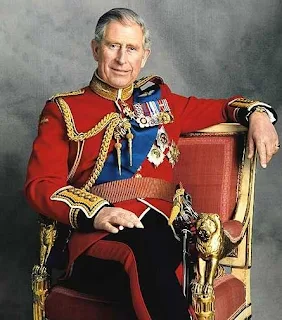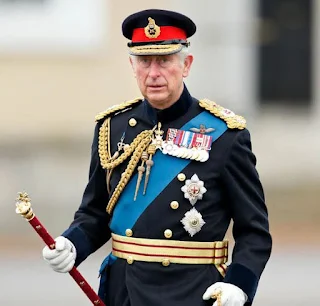Following Queen Elizabeth II's death on September 8, 2022, in Balmoral estate, Scotland, the British monarchy faces major transitions as King Charles III begins his reign. A new era also now unfolds.
King Charles III's era will be known as the Carolinian era because his name, Charles, is derived from the word, Carol, which originated in the German language, or Carlo in Spanish.
He is the third Charles to reign as monarch in British history after the two Stuart kings - Charles I and Charles II. He is also the longest heir-apparent of the British throne, having held the position since February 6, 1952.
 |
| His Majesty King Charles III |
He is the newest Glucksburg prince to become King in Europe. His father, Prince Philip, Duke of Edinburgh, was a Glucksburg prince who directly descended from the male line of the royal House of Glucksburg.
King Charles III is the third European reigning monarch who is Glucksburg by bloodline after King Harald V of Norway and Queen Margrethe II of Denmark.
So what are the major changes in the House of Windsor?
- The national anthem will now change to "God Save The King"
- King Charles III is the new head of the House of Windsor
- He has been very vocal in saying he wants a slim monarchy, which means that only his direct descendants will be considered working members of the House of Windsor.
- His wife, Camilla, will be crowned with him as Queen Consort just like the previous wives of the British kings.
- His two grandchildren: Archie and Lilibet, are now legally Prince Archie of Sussex and Princess Lilibet of Sussex, unless Prince Harry and Meghan chose not to.
- Prince William automatically assumes the title Duke of Cornwall upon the Queen's death. He is now Duke of Cornwall and Cambridge.
- Prince William will now take over the management of the duchy of Cornwall, which is primarily the source of income and finances of the heir-apparent to the British throne.
- William and Kate are now known as the Duke and Duchess of Cornwall and Cambridge.
- The three Cambridge children are now Prince George, Princess Charlotte, and Prince Louis of Cornwall and Cambridge.
- The newly ascended king and his Queen Consort will possibly vacate the Clarence House and move to the official residence of the British monarch - Buckingham Palace.
- The youngest son of the Queen, Prince Edward, the Earl of Wessex, can now be given the title Duke of Edinburgh. In 1999, it was reported that Prince Philip's heir to his Edinburgh dukedom would be his youngest son, however, the title can only be given to Edward when Charles becomes king.
- (Update after the King's Speech) King Charles III addressed the nation for the first time after the death of his mother. In his speech, he officially granted Prince William the title Prince of Wales. William will be known as Duke of Rothesay when he is in Scotland.
- Prince William, the Duke of Cornwall and Cambridge - eldest son of Charles III
- Prince George of Cornwall and Cambridge - son of Prince William
- Princess Charlotte of Cornwall and Cambridge - daughter of Prince William
- Prince Louis of Cornwall and Cambridge - son of Prince William
- Prince Harry, the Duke of Sussex - second son of Charles III
- Archie Mountbatten-Windsor - son of the Duke of Sussex
- Lilibet Mountbatten-Windsor - daughter of the Duke of Sussex
- Prince Andrew, the Duke of York - second son of Elizabeth II
- Princess Beatrice, Mrs. Edoardo Mapelli-Mozzi - eldest child of the Duke of York
- Sienna Elizabeth Mapelli-Mozzi - daughter of Princess Beatrice
- Princess Eugenie, Mrs. Jack Brooksbank - younger child of the Duke of York
- August Philip Hawke Brooksbank - son of Princess Eugenie
- Prince Edward, the Earl of Wessex - youngest son of Elizabeth II
- James Mountbatten-Windsor, Viscount Severn - son of the Earl of Wessex
- Lady Louise Mountbatten-Windsor - daughter of the Earl of Wessex
- Princess Anne, the Princess Royal - daughter of Elizabeth II
- Peter Phillips - son of the Princess Royal
- Savannah Phillips - eldest child of Peter Phillips
- Isla Phillips - youngest child of Peter Phillips
- Zara Phillips-Tindall - daughter of the Princess Royal
- Mia Tindall - eldest child of Zara Tindall
- Lena Tindall - second child of Zara Tindall
- Lucas Tindall - third child of Zara Tindall
- David Armstrong-Jones, 2nd Earl of Snowdon - son of Princess Margaret (the youngest daughter of George VI)
- Charles Armstrong-Jones, Viscount Linley - son of 2nd Earl of Snowdon
- Lady Margarita Armstrong-Jones - daughter of the 2nd Earl of Snowdon
- Lady Sarah Chatto - daughter of Princess Margaret
- Samuel Chatto - eldest son of Lady Sarah Chatto
- Arthur Chatto - younger son of Lady Sarah Chatto
- Prince Richard, the Duke of Gloucester - son of Prince Henry, Duke of Gloucester (third son of George V)
- Alexander Windsor, Earl of Ulster - son of the Duke of Gloucester
- Xan Windsor, Lord Culloden - son of the Earl of Ulster
- Lady Cosima Windsor - daughter of the Earl of Ulster
- Lady Davina Windsor - eldest daughter of the Duke of Gloucester
- Senna Lewis - eldest child of Lady Davina
- Tane Lewis - youngest child of Lady Davina
- Lady Rose Windsor-Gilman - youngest daughter of the Duke of Gloucester
- Lyla Gilman - eldest child of Lady Rose
- Rufus Gilman - youngest child of Lady Rose
- Prince Edward, the Duke of Kent - eldest child of Prince George, Duke of Kent (fourth son of George V) Note: the youngest child of Prince Edward - Lord Nicholas Windsor was removed from the line of succession because he converted to Roman Catholicism. However, his three sons: Albert, Leopold, and Louis who are in communion with the Church of England, retained their places in the line of succession.
- George Windsor, Earl of St. Andrews - eldest son of the Duke of Kent (his two children: Edward and Lady Marina were removed also because they converted to Roman Catholicism)
- Lady Amelia Windsor - daughter of the Earl of St. Andrews
- Albert Windsor - son of Lord Nicholas Windsor
- Leopold Windsor - son of Lord Nicholas Windsor
- Louis Windsor - son of Lord Nicholas Windsor
- Lady Helen Windsor-Taylor - eldest daughter of the Duke of Kent
- Columbus Taylor - son of Lady Helen
- Cassius Taylor - son of Lady Helen
- Eloise Taylor - daughter of Lady Helen
- Estella Taylor - daughter of Lady Helen
- Prince Michael of Kent - youngest son of Prince George, Duke of Kent
- Lord Frederick Windsor - son of Prince Michael of Kent
- Maud Windsor - elder daughter of Lord Frederick Windsor
- Isabella Windsor - younger daughter of Lord Frederick Windsor
- Lady Gabriella Windsor-Kingston - daughter of Prince Michael of Kent
- Princess Alexandra, Lady Angus Ogilvy - daughter of Prince George, Duke of Kent (fourth son of George V)
- James Ogilvy - son of Princess Alexandra
- Alexander Ogilvy - son of James Ogilvy
- Flora Ogilvy-Vesterberg - daughter of James Ogilvy
- Marina Ogilvy - daughter of Princess Alexandra













0 Comments